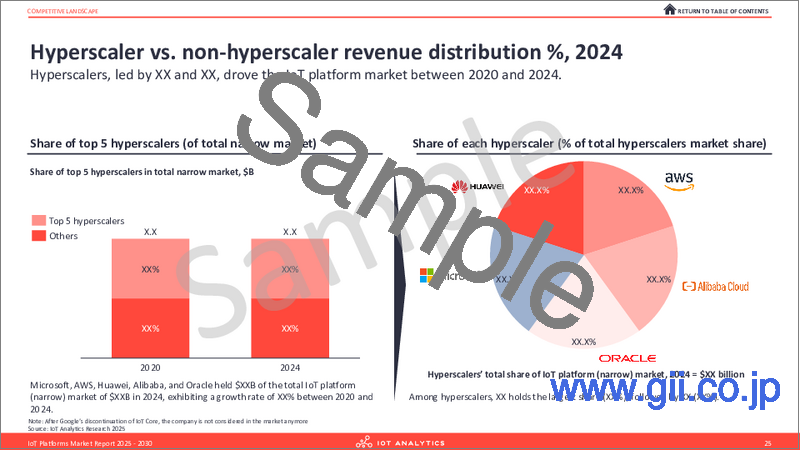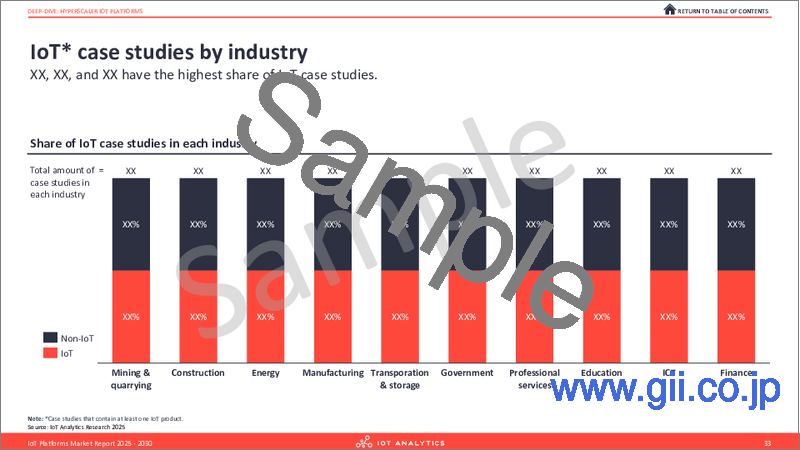|
|
市場調査レポート
商品コード
1780882
IoTプラットフォーム市場:2025-2030年IoT Platforms Market Report 2025-2030 |
||||||
|
|||||||
| IoTプラットフォーム市場:2025-2030年 |
|
出版日: 2025年07月31日
発行: IoT Analytics GmbH
ページ情報: 英文 PDF - 228 Pages
納期: 即日から翌営業日
|
全表示
- 概要
- 目次
当レポートは、企業向けおよび産業向けIoTプラットフォーム市場を詳細に調査し、市場規模、競合情勢、主要動向、課題を掲載しています。
サンプルプレビュー


IoTプラットフォーム市場は、技術革新、ベンダーの統合、企業ニーズの変化によって、急速に進化し続けています。このエコシステムに関わるリーダーにとって、こうした構造的変化を先取りするためには、詳細かつ客観的な理解が不可欠です。
サンプルプレビュー


レポート概要
- PDFレポート (228ページ):企業および産業用IoTプラットフォームの市場情勢を概説した詳細な資料
- EXCELデータシート:完全な市場モデルと2030年までの予測、500社以上のIoTプラットフォーム企業リストを収録
- 主要ベンダー12社の分析:現在の市場シェアと主要ベンダー5社の詳細なプロファイルを掲載
- 5つの企業ケーススタディ:実際の実装の青写真を詳述
- 5つの主要動向、5つの課題、2つの検討事項の分析:主要な市場力学の将来の展望
サンプルプレビュー


回答されている主な質問:
- IoTプラットフォームとは何か?その定義と対象範囲には何が含まれるか?
- IoTプラットフォーム市場は近年どのように変化してきたか?
- IoTプラットフォームのスタックにはどのようなレイヤー、コンポーネント、サブコンポーネントが含まれるか?
- 地域および産業別に見たIoTプラットフォームの市場規模はどのくらいか?
- 主要なIoTプラットフォームベンダーは誰か?また、それぞれのベンダーを比較するとどうか?
- 注目すべきIoTプラットフォームの導入事例にはどのようなものがあるか?
- 建設、産業オートメーション、ロボティクス分野におけるIoTプラットフォームの特徴は?
- IoTプラットフォーム分野における主要な動向や課題は何か?
掲載企業
|
|
|
目次
第1章 エグゼクティブサマリー
第2章 イントロダクション
第3章 技術概要
第4章 市場規模と展望
- 概要
- 広義のIoTプラットフォーム市場
- 狭義のIoTプラットフォーム市場
- 過去10年間におけるIoTプラットフォーム市場の進化
- 2025年のIoTプラットフォーム市場の一般的な促進要因と阻害要因
- 世界のIoTプラットフォームへ支出:レイヤー別
- 世界のIoTプラットフォームへ支出:地域別
- 東アジア・太平洋地域のIoTプラットフォームへ支出:国別
- 北米地域のIoTプラットフォームへ支出:国別
- 欧州・中央アジア地域のIoTプラットフォームへ支出:国別
- 世界のIoTプラットフォームへ支出:産業別
第5章 競合情勢
第6章 ケーススタディ
第7章 ディープダイブ:ハイパースケーラーIoTプラットフォーム
第8章 ディープダイブ:製品連携IoTプラットフォーム
第9章 動向と課題
第10章 調査手法と市場の定義
第11章 IoT Analyticsについて
A 228-page report detailing the market for enterprise and industrial IoT platforms, incl. market size, competitive landscape, key trends and challenges.
Sample preview


Introduction
The IoT platforms market continues to evolve at a rapid pace, driven by technological advancements, vendor consolidation, and shifting enterprise needs. For leaders invested in this ecosystem, staying ahead requires a detailed and objective understanding of these structural changes.
As part of IoT Analytics' ongoing coverage of IoT platforms and software, this report's main purpose is to help readers understand the current IoT platform landscape by defining, sizing, and analyzing the market. The information presented is based on the results of a survey, secondary research, and qualitative primary research, including interviews with IoT platform experts, vendors, and end users.
The result is a 228-page, data-driven analysis of the current and future state of the IoT platforms market. It includes definitions for the IoT platform and its components, market projections, analysis of the competitive landscape, a deep dive into hyperscalers' IoT platforms and product-linked IoT platforms, key trends and challenges, and case studies. The report is compiled to serve as a foundational intelligence asset for leaders responsible for strategy, product development, and investment within the IoT space.
Sample preview


Report at a glance
- 228-page PDF report: A detailed document outlining the enterprise and industrial IoT platforms market landscape.
- EXCEL datasheet: Includes the full market model and forecasts to 2030 & a list of +500 IoT platform companies.
- Analysis of 12 leading vendors: With current market shares and in-depth profiles of 5 key vendors.
- 5 enterprise case studies: Detailing real-world implementation blueprints.
- Analysis of 5 key trends, 5 challenges, and 2 further considerations: A forward-looking view of key market dynamics.
Sample preview


The report's analysis includes an in-depth look at several key areas:
- Market structure & evolution: An examination of the market's development over the past 10 years, including the initial proliferation of vendors, subsequent market exits, and the pivot toward solution-based models.
- Competitive landscape and vendor positioning: A detailed assessment of the top 12 vendors.
- Technology stack deep dive: A granular breakdown of the modern IoT platform into its 5 core layers and 14 key components, providing a technical baseline for product and development teams. The report further analyzes the specific platform architectures of both hyperscalers and product-linked OEMs in dedicated chapters.
- Real-world adoption and implementation patterns: An analysis of five distinct enterprise case studies, detailing the architectural decisions, challenges, and outcomes of IoT platform deployments at large industrial and technology firms.
A data-driven foundation for key business functions:
This research is designed to provide a data-driven foundation for key business functions:
- For corporate strategy & M&A: The report's market sizing, forecasts, and competitive landscape analysis provide the quantitative and qualitative backing needed to assess market entry, evaluate investment opportunities, and perform due diligence.
- For product management & marketing: The detailed analysis of vendor strategies, technology trends, and real-world use cases offers the necessary intelligence to benchmark product roadmaps, refine value propositions, and identify differentiation opportunities.
- For CTOs & technical leadership: The in-depth technology overview and architectural breakdowns of leading platforms provide a clear view of the current best practices and future technological trajectory of the market.
- For market intelligence & analysis: This report serves as a central, objective source of market data and vendor intelligence, enabling teams to build upon our findings for their own internal briefings and analyses.
What is an IoT platform?
Definition:
An IoT platform is a software-based technical platform that provides the necessary components for building and operating multiple IoT solutions. IoT platforms act as a middleware layer designed to:
- Manage connected devices.
- Collect and process their data.
- Enable the development and management of IoT applications and services.
Core components:
An IoT platform consists of 5 distinct layers, 14 components, and 44 sub-components:
- Essentials: These components enable bi-directional data exchange between IoT devices and the IoT platform (southbound), and between the IoT platform and external applications or services (northbound).
- Device management: This layer comprises lifecycle management, monitoring, firmware & software updates, and device security. It enables processes from device registration to retirement, tracks device health, delivers OTA updates, and enforces security.
- Data management: This layer spans IoT data transformation, digital twin modeling, analytics, and data security. It ensures data quality, builds digital replicas of physical assets, delivers insights, and protects data.
- Application management: This layer covers application development, lifecycle management, marketplace, and application security. It provides toolkits for building applications, enables deployment and updates, and ensures secure APIs.
Questions answered:
- What are IoT platforms and what is included in their scope (i.e., IoT platform definition)?
- How did the IoT platform market change in the last years?
- Which layers, components, and sub-components are included in the IoT platform stack?
- What is the total market size of IoT platforms by regions and industries?
- Who are the leading IoT platform vendors and how do they compare to each other?
- What are some notable IoT platform case studies?
- What are some of the specifics of IoT platforms in construction, industrial automation, and robotics?
- What are the key trends and challenges in the IoT platforms space?
Companies mentioned:
A selection of companies mentioned in the report.
|
|
|
Table of Contents
1. Executive Summary
2. Introduction
3. Technology overview
4. Market size & outlook
- 4.1. Overview
- 4.2. Wider IoT Platform Market
- 4.3. Narrow IoT Platform Market
- 4.4. How the IoT platforms market evolved over the past 10 years
- 4.5. General drivers and inhibitors for the IoT platforms market 2025
- 4.6. Global spending on IoT platforms by layer
- 4.7. Global spending on IoT platforms by region
- 4.8. Global spending on IoT platforms by country in East Asia & Pacific
- 4.9. Global spending on IoT platforms by country in North America
- 4.10. Global spending on IoT platforms by country in Europe and Central Asia
- 4.11. Global spending on IoT platforms by industry





